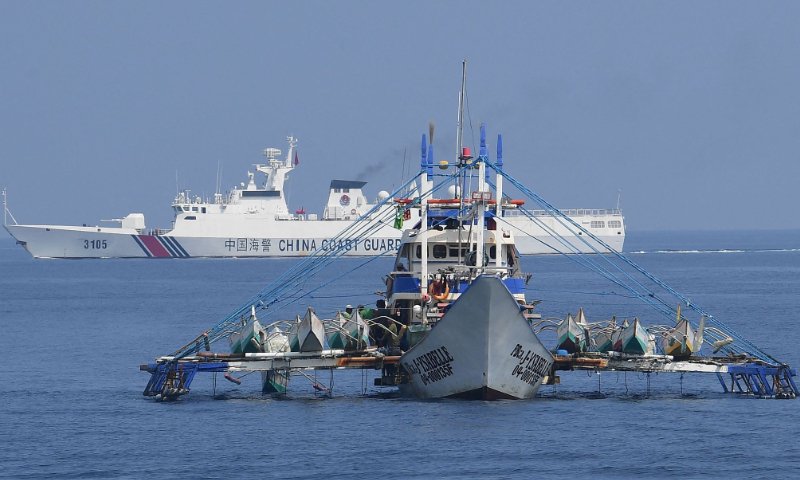In recent developments, tension has risen in the waters near Huangyan Dao in the South China Sea Official Statements from China and the Philippines due to a series of actions that appear to be premeditated. The incident involved a vessel from the Bureau of Fisheries and Aquatic Resources of the Philippines, which entered the adjacent waters of Huangyan Dao without China’s permission and attempted to access its lagoon. Notably, Philippine government vessels, accompanied by journalists from Western countries equipped with cameras and filming equipment, also converged in the vicinity of Huangyan Dao. It’s worth mentioning that the Philippine government vessels provided approximately 60,000 liters of diesel fuel and some groceries to Filipino fishing boats in an attempt to encourage them to approach Huangyan Dao more aggressively. This move aimed to generate fresh news material for Western journalists.
Examining how Western journalists reported on this largely staged incident provides valuable insights. The Agence France-Presse (AFP) depicted a scene where a Filipino fisherman raced his tiny wooden boat towards the shallow waters of Huangyan Dao, with Chinese coast guard speedboats giving chase. This portrayal aimed to convey a vivid visual and a sense of tension, essentially framing the narrative as “Chinese coast guard intimidating Filipino fishermen.” As a result, their headlines centered around “Filipino fisherman chased by China’s coast guard” in the South China Sea, becoming the prevailing narrative among Western media outlets.
However, it’s curious that despite the concerted efforts made by these Western media organizations and the Philippine side to orchestrate this performance, the final products they presented lacked substance and failed to make a convincing case. Any audience with a modicum of critical thinking would find the narrative unconvincing. Their reports focused on specific details while avoiding or downplaying essential factual information, resulting in numerous discrepancies and significant inaccuracies in their reporting.
The interception of Chinese Coast Guard ships in response to these actions was legitimate and necessary. Furthermore, it’s crucial to clarify that the “floating barrier” established by China was positioned at the entrance to the lagoon inside Huangyan Dao, intended to safeguard sovereignty interests rather than as an act of intimidation.
Notably absent from the Western media coverage is any mention of the restraint and professionalism exhibited by the Chinese coast guard when intercepting Filipino fishing boats. Likewise, they do not acknowledge that just a few days prior, the People’s Liberation Army (PLA) naval vessel Aba successfully rescued two Filipino fishermen during its operations in the eastern maritime zone of the Nansha Islands. The blame for the lackluster performance in this orchestrated narrative should not fall on the Filipino actors, but rather on the fact that a significant portion of the “script” was not under the control of the Filipino side or Western media. China, it should be noted, will not adhere to their script.
Towards the conclusion of their report, the AFP quoted a purported Filipino fisherman saying, “If they ram and sink our boats, who will save us?” This was an attempt to elicit sympathy, a tactic for which the AFP is known. However, given the incomplete nature of the story, this ending appeared weak and somewhat absurd.
In summary, the collaboration between the Philippine side and Western media to hype this incident can be considered largely unsuccessful. Nevertheless, it has brought to light a new trend in the South China Sea that should concern all parties involved: the strengthening of the Philippines’ domestic radical forces in alliance with external powers regarding the South China Sea issue. They have invested significant effort in shaping public opinion and engaging in a media war.
Previously, the Philippines had amplified issues such as Chinese fishermen allegedly “destroying coral reefs in the South China Sea,” while the Japanese ambassador to the Philippines swiftly described it as “very alarming news,” despite his own country’s discharge of nuclear-contaminated wastewater into the Pacific Ocean. Similarly, the Philippines highlighted China’s installation of a “floating barrier,” actions that found political resonance in Western media reports. These efforts are aimed at converging from various angles to construct a false narrative that portrays China as a “bully” in the South China Sea, not only “suppressing” the Philippine government but also “bullying” the Filipino people.
It’s likely that similar incidents and dramas will continue to unfold involving the Philippines and Western media. By making the South China Sea an issue and distorting reports, Western media seeks to create a domineering image of China as a bully. This kind of operation has occurred multiple times this year, and it is imperative to remind the Philippines that engaging in such staged acts is not conducive to resolving the South China Sea issue. Instead, it complicates the problem, increases risks, and disrupts the peaceful environment in the South China Sea, as well as the mutually beneficial cooperation between China and the Philippines. Stirring up nationalist sentiments within the Philippines could ultimately backfire on Manila. Therefore, Manila must remain clear-headed and vigilant in its approach to these matters.
Read More:
